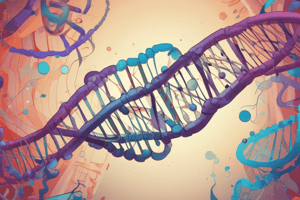Podcast
Questions and Answers
What is the primary function of DNA in an organism?
What is the primary function of DNA in an organism?
- Synthesize energy for cellular processes
- Carry hereditary factors in genes (correct)
- Provide structural support to cells
- Regulate cellular metabolism
Which of the following correctly identifies the role of proteins?
Which of the following correctly identifies the role of proteins?
- Control cell division
- Transport molecules across membranes
- Determine an organism's traits (correct)
- Store genetic information
Which of the following statements best describes the relationship between genes and proteins?
Which of the following statements best describes the relationship between genes and proteins?
- Genes code for proteins that influence traits (correct)
- Genes are made of proteins
- Proteins are produced in the nucleus
- Proteins directly alter gene structure
What is a mutation?
What is a mutation?
Where within a cell are chromosomes located?
Where within a cell are chromosomes located?
Which term accurately defines the characteristic passed through generations?
Which term accurately defines the characteristic passed through generations?
Which pair of bases correctly matches in DNA?
Which pair of bases correctly matches in DNA?
What component of a cell is described as the control center that contains chromosomes?
What component of a cell is described as the control center that contains chromosomes?
Flashcards
Nucleus
Nucleus
The structure inside a cell that contains chromosomes, which are made of DNA.
Gene
Gene
A small section of a chromosome that carries the instructions for a specific trait.
Chromosome
Chromosome
A long, thread-like structure that carries genes. It's located in the nucleus of a cell.
Trait
Trait
Signup and view all the flashcards
DNA
DNA
Signup and view all the flashcards
Protein
Protein
Signup and view all the flashcards
Mutation
Mutation
Signup and view all the flashcards
Base pairing in DNA
Base pairing in DNA
Signup and view all the flashcards
Study Notes
DNA Structure and Function
- DNA is a structure containing hereditary factors located in genes on chromosomes.
- The nucleus contains chromosomes.
- A gene is a small segment of a chromosome.
- A chromosome is a structure that carries genes.
- A trait is a characteristic passed down through generations.
- Examples of traits include brown hair, blue eyes, curly hair, and dimples.
- Proteins determine an organism's traits. They are needed for building muscles and organs, growth, repair, and cell replacement.
- Genes code for proteins, which create traits.
- A mutation is a change in the DNA code that can be beneficial, harmful, or have no effect.
DNA Base Pairing
- DNA is a sequence of bases (A, T, C, G).
- Adenine (A) pairs with Thymine (T).
- Guanine (G) pairs with Cytosine (C).
Cell Structure and Genetic Material
- The cell has a nucleus, which is the control center.
- Chromosomes are coiled DNA located in the nucleus.
- DNA, genes, protein, and traits are related.
- DNA carries hereditary factors in genes.
- Genes tell the cells how to make proteins.
- Proteins make up traits.
Studying That Suits You
Use AI to generate personalized quizzes and flashcards to suit your learning preferences.




